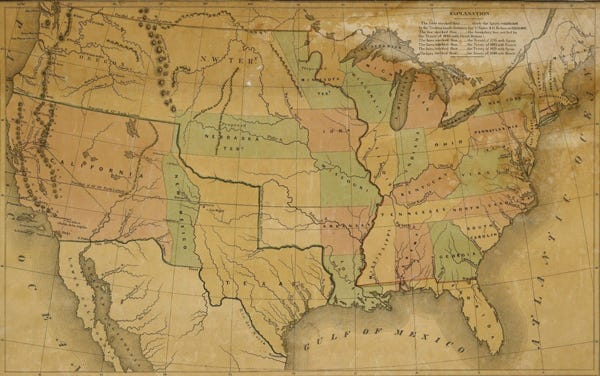Welcome to new subscribers and regular readers! Thank you for joining me for today’s song, “St. Patrick Battalion” by David Rovics. If you’d like to hear the song before you read about it, I’ve included a YouTube video below the article.
Below, you’ll find my interpretation of the lyrics which are written in italics. For Japanese students, vocabulary words in bold are provided in Japanese below. TOEIC (PBT) 450+, Eiken 2, CEFR B1.
(867 words)
The background
For hundreds of years, England and Ireland didn't get along. England wanted to rule Ireland and started sending lots of people to live there. These people were mostly Protestant, and they took land away from the Irish people, who were mostly Catholic.
In the late 1700s, there were revolutions in France and in the United States. The Irish also wanted to be free from British rule. The Irish people fought back against these English people, but they lost. Then, the Protestants got even more powerful after other battles, and the Irish Catholics had a hard time keeping their land.
From 1845-1852, The Great Famine (the Irish Potato Famine) occurred. There was a disease that attacked the potato crops. Potatoes were the main food for many Irish people. The Great Famine had another cause. Even when people were starving, England kept taking food like wheat and oats from Ireland and sending it to England. Soldiers even guarded the food so it couldn't be given to the hungry Irish people. So, while Ireland was suffering, food was being sent away. Many thousands of Irish people left Ireland and went to the U.S.
Around that time, the U.S. was involved in a conflict with Mexico over land. Texas said that it was now independent from the country of Mexico, but Mexico said that Texas was still part of its country. The U.S. Army moved in, and the Mexican-American War started. The Army included many Irish soldiers. The U.S. won important battles, captured Mexico City, and forced Mexico to sign the Treaty of Guadalupe Hidalgo. Mexico lost nearly half its land, including California, Arizona, and Texas. Many Mexicans saw it as an invasion, while Americans called it expansion.
During the war (1846-1848), a group of 202 soldiers left the U.S. Army and joined the Mexican Army instead. Most of them were Irish, but some were from Poland and Wales, too. They fought in five big battles under General Santa Anna. Many of these soldiers, called the San Patricios, died in battle. Fifteen were caught and hanged for leaving the U.S. Army. Some escaped and made new homes in Mexico City, married and had children.

The song
My name is John Riley
I’ll have your ear only a while
“I’ll have your ear” means “you will listen to me”.
I left my dear home in Ireland
It was death, starvation or exile, meaning many Irish could choose between dying in Ireland fighting for independence, starving because there wasn’t enough food, or being forced to leave Ireland (exile).
And when I got to America
It was my duty to go
Enter the Army and slog across Texas
To join in the war against Mexico
While the soldier was fighting, he saw how the U.S. soldiers acted, killing people who were defending their homeland from their towns (pueblos).
It was there in the pueblos and hillsides
That I saw the mistake I had made
Part of a conquering army
With the morals of a bayonet blade
Seeing this, the soldier decided to help the people of Mexico. The soldier felt a kind of solidarity with them because they were also Catholics.
So in the midst of these poor, dying Catholics
Screaming children, the burning stench of it all
Myself and two hundred Irishmen
Decided to rise to the call
From Dublin City to San Diego
We witnessed freedom denied
So we formed the Saint Patrick Battalion
And we fought on the Mexican side
We marched ‘neath the green flag of Saint Patrick
Emblazoned with “Erin Go Bragh”
Bright with the harp and the shamrock
And “Libertad para la Republica” (Freedom for the Republic)
In the 1700s, there was an Irishman named Wolfe Tone. He also thought it was unfair that the English should be in power over his country, so he wanted Ireland to be free. He became one of the leaders of the 1798 rebellion against the British rulers.
Just fifty years after Wolfe Tone
Five thousand miles away
The Yanks called us a Legion of Strangers
And they can talk as they may
The song mentions several cities in Mexico where the Irish soldiers fought. Many Irish people have red hair and very light skin.
We fought them in Matamoros
While their volunteers were raping the nuns
In Monterey and Cerro Gordo
We fought on as Ireland’s sons
We were the red-headed fighters for freedom
Amidst these brown-skinned women and men
Side by side we fought against tyranny
And I daresay we’d do it again
We fought them in five major battles
Churobusco was the last
Overwhelmed by the cannons from Boston
We fell after each mortar blast
Most of us died on that hillside
In the service of the Mexican state
So far from our occupied homeland
We were heroes and victims of fate

In the end, the Mexican Army lost the war, and was forced to give about half of its land to the U.S. This is the area which is now California, Arizona, New Mexico, western Colorado, Nevada, Utah and Texas. The U.S. paid Mexico only $15 million.
St. Patrick’s Day is March 17, a good time to remember these defenders against tyranny in a foreign land.
Question
• Do you celebrate St. Patrick’s Day in your county or culture?
• What questions do you have about the song or the meaning of the lyrics?
Vocabulary
capture 捕獲
invasion 侵略
starvation 飢餓
exile 亡命
slog 困難や労力を伴って歩いたり動いたりする
conquer 打ち勝つ
morals 道徳
bayonet 銃剣
in the midst of そんな中
stench 悪臭
witness 証人
deny 打ち消す
‘neath (beneath) ~の下
emblazon 何かにデザインを目立つように刻んだり、表示したりすること
yanks (yankee アメリカ人)
nun 尼
tyranny 横暴
daresay 何かが可能性が高いと信じていることを示すために使用されるフレーズ
overwhelmed 打ちのめされた
mortar blast 迫撃砲の爆発
occupied 占拠した
Sources
A&E Television Networks. When America despised the Irish: The 19th century’s refugee crisis. History.com. https://www.history.com/news/when-america-despised-the-irish-the-19th-centurys-refugee-crisis Accessed 30 April 2025.
Encyclopædia Britannica, inc. (2025, March 7). Treaty of guadalupe hidalgo. Encyclopædia Britannica. https://www.britannica.com/event/Treaty-of-Guadalupe-Hidalgo . Accessed 30 April 2025.
National Army Museum. Irish rebellion of 1798. https://www.nam.ac.uk/explore/irish-rebellion-1798#:~:text=In%20October%201791%2C%20the%20Society,group%20of%20like%2Dminded%20associates . Accessed 30 April 2025.
National Army Museum. Irish revolution. Cost of Revolution. https://www.amrevmuseum.org/virtualexhibits/cost-of-revolution/pages/part-4-irish-revolution#:~:text=French%20Invasions&Theobald%20Wolfe%20Tone%2C%20a%20leader,Donegal%2C%20on%20Ireland’s%20northern%20coast . Accessed 30 April 2025.
St. Patrick Battalion. Rovics, D. https://www.davidrovics.com/songbook/st-patrick-battalion-2/ . Accessed 29 April 2025.
Read more about the Great Famine:
Heroes And Survivors
Welcome to new subscribers and regular readers! Thank you for joining me for today’s song, “Heroes And Survivors” by Jim Page (2013). If you’d like to hear the song before you read about it, I’ve included a YouTube video below the article. Below, you’ll find my interpretation of the lyrics which are written in italics.
英検2級以上 | 名曲で英語を学ぶ








I lived in Ireland for thirteen years Louise as you may have gathered from some of my posts, when we first arrived there were still many older people that were suspicious of us, they wouldn't speak or even say hello... I know it was history talking to them but I did feel so ashamed... the English, like the Americans too, did some terrible things in the name of greed.. ☘️
Louise, same as the previous two comments, thank you for sharing another very important history lesson song and your enlightening explanation. Your “Social Issues in Song” articles have been a precious source for me to learn world history, and today’s song, too.
After reading your article and listening to the song, my computer or YouTube automatically led me to a video clip at:
https://www.youtube.com/watch?v=4OkDpD-sUYI&t=45s
(When Americans fought for Mexico: St Patrick's Battalion, an episode of “Five Minutes of History” by the History Guy)
So I watched it. I found it a good follow-up mini-lecture to understand the situation. I watched it to the end without realizing that it was a "Ten" Minutes of History, and I felt embarrassed that, not knowing the history behind Saint Patrick’s Day, I have formed a self-made, non-essential image about the Day. I now feel I know just a little bit more about the Day. I’m sure that next time on when I hear the word “Saint Patrick’s Day,” I will recall today’s song and your article. Thank you.
Not to change the subject, the other day my YouTube led me to a short (1 minute) video clip:
https://www.youtube.com/shorts/rJmE-u6UPoQ
Looks like it is a scene from a TV drama. I felt that a very important lessen is condensed in this one minute. I felt that it helped me understand the logic or way of thinking behind what happened or was going on in the world (almost everywhere, between countries/peoples or within).
Lastly and least, I have a least important question about the lyrics.
The third line from the bottom (end) says “In the service of the Mexican-state.” The video says “At the service of ...” Doesn’t matter whether it is IN or AT?
We fought them in five major battles
Churobusco was the last
Overwhelmed by the cannons from Boston
We fell after each mortar blast
Most of us died on that hillside
"In" the service of the Mexican state
So far from our occupied homeland
We were heroes and victims of fate
Mitsuru Hiki